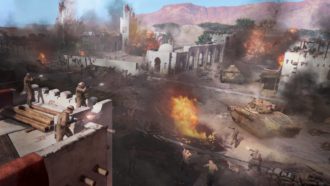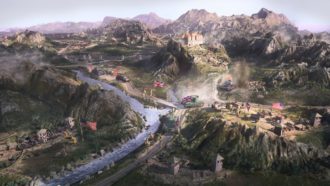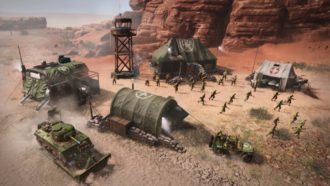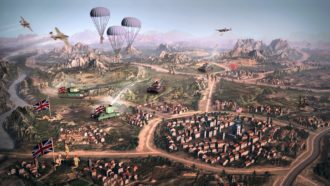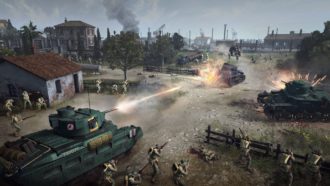Platforms:
PC, PS5, Xbox Series X|S
Released:
February 23, 2023
Publisher:
Sega
Developer:
Relic Entertainment
Company of Heroes 3 is a real-time strategy game developed by Relic Entertainment and published by Sega. It’s the latest entry in the Company of Heroes franchise, which started with the original Company of Heroes in 2006, and comes with a single-player campaign mode, PvP multiplayer, and a co-op multiplayer mode.
Historically, Company of Heroes is considered one of the iconic franchises in the strategy world. Known for its real-time strategy mechanics and historical settings, the series has built up a huge following since its first release in the early 2000s. A dedicated mod community has thrived alongside it over the years. Given the series’ large fan base and the fact that it has been over ten years since the release of Company of Heroes 2, it’s easy to understand why the anticipation ahead of Company of Heroes 3’s release has been running high. We got a preview of the game in July and liked what we saw. So what do we think now after going hands-on with the full release?
If you count yourself among the die-hard Company of Heroes fans, you’re in luck: Relic entertainment has retained plenty of the gameplay elements that the franchise is known for. Like its predecessors, the game is set during World War II. Whilst previous games took place in Second World War France and Russia, Company of Heroes 3 is set on sunnier shores: the game comes with a single-player campaign set in North Africa, and one set in Italy. Every gameplay map—whether it’s the desert or a lush Italian landscape—is beautifully rendered, and the game’s visuals look realistic and help create an immersive atmosphere. The same goes for units, uniforms, tanks, and weapons. There are four factions to choose from—the German Wehrmacht, the Deutsches Afrikakorps, the British forces, and the US forces—and each one comes with units, barks, and dialogue. The voice acting is suitably realistic and dramatic without ever tipping over into cheesiness. Gameplay-wise, each of these factions comes with perks and drawbacks: where the Wehrmacht is a great faction for those playing defensively with anti-vehicle units like the StuG, the US forces instead come with light vehicles perfect for an aggressive play style.
“…it’s clear that a lot of love has been poured into Company of Heroes 3.”
While these four factions are very well developed and add plenty of variety to the overall gameplay experience, the game’s centrepieces are undoubtedly the single-player campaigns. If you’re not familiar with Company of Heroes’ traditional campaign format, the concept is simple: a campaign consists of various missions that are loosely woven together with a narrative told through cutscenes. Each mission has different objectives, ranging from breaking through enemies’ defences to recovering resources. The more key territory, base buildings, and resources you’re able to secure, the more you’ll be able to ramp up your own production, producing stronger units, tanks, and gear in the process. To help pave the way to victory, individual units can also pick up resources and weapons as they traverse the map. The better a unit’s gear and the more battles they survive, the higher their veterancy rating will be, which, in turn, will make them a more deadly unit on the battlefield. The deadlier your units, the easier it will be to dominate the map and capture core resources and territory.
At times, campaigns will feature skirmish matches against AI. While unit production and map domination are key in these matches, the overall focus is on capturing ‘victory points’ on the map. These are specific markers on a Company of Heroes map that you can occupy with your units. When starting a skirmish, both players start with five hundred overall game points. If you lose all points before your opponent, you lose the match. If you manage to outlast your opponent, however, you’ll emerge victorious. To drain your rival’s point score dramatically you’ll need one thing: victory points. If you manage to station a unit at a specific victory point for long enough and keep them there, the victory point will become yours. This will dramatically drain points from your opponent for as long as you’re able to hang on. Once you hold the majority of victory points on the map, the overall victory is inevitably yours.
Company of Heroes 3’s North African campaign follows this traditional COH campaign format of skirmishes and mission objectives to a tee: playing as the Deutsches Afrikakorps, you’re guided through the campaign’s story by Feldmarschall Erwin Rommel, who outlines a risky mission in the battle of Alamein in 1942. The overall campaign consists of eight missions and roughly takes seven to eight hours to complete. Through the cutscenes sandwiched between missions, you’ll discover the story of a North African Jewish family impacted by the horrors of the Second World War. Overall, the sand-coloured graphics, emotive voice acting, and map variety all make the North African campaign engaging from beginning to end. While the mission objectives are suitably varied, the map design is truly what steals the show. The distribution of obstacles, walls, and buildings means you’ll have to be mindful of how you move your units across the map. Both desert and urban environments have been engineered to challenge players to think outside of the box; grouping units and flanking to draw enemies away from cover are key, and at times gameplay feels like an enjoyable puzzle.
Time is of the essence in Company of Heroes 3, Particularly on the game’s more complex map. This is why the tactical pause feature—a button allowing you to pause the game and stack orders for your units—is a godsend. Having time to formulate an overall strategy is a great way to appreciate the complexity of a map and understand the movement of enemy troops. For less experienced players, the tactical pause feature functions as a useful tool to get the hang of the game’s core mechanics. Even though the game comes with a thorough tutorial that makes Company of Heroes 3’s core mechanics easy to grasp, there’s nothing like a raging campaign battle to understand the nuances between different factions and see how a map’s layout influences overall strategy.
The only thing that felt like a missed opportunity in the North African campaign was the story. Following a Jewish family being impacted by raids, the cutscenes feel like standalone interludes rather than an integrated story, which is a shame considering the otherwise cohesive mission gameplay. While including the story of a family ravaged by the realities of war may be a worthwhile choice on Relic’s part, it largely feels disconnected from the minute-to-minute gameplay. Going from salvaging your squads on the battlefield to a story cutscene set in a family home is such an abrupt change of pace that it makes it harder to connect with the story’s main characters.
“Set on a sprawling map from Palermo to Rome, it’s clear that the developers see it as the crown jewel of Company of Heroes 3.”
The Italy campaign, however, is very different from the North African one. Set on a sprawling map from Palermo to Rome, it’s clear that the developers see it as the crown jewel of Company of Heroes 3. Unlike the linear North African campaign, the campaign in Italy is dynamic in nature and can be completed in different ways. While you start in Palermo and the end goal is to capture Rome, you can crisscross the map in any way you like. By leveraging groups of units called companies, you’ll be able to capture your way to the country’s capital town by town, with a battle only breaking out when you decide to attack. In this sense, the gameplay feels more like an open-world strategy franchise like Total War rather than the traditional Company of Heroes.
While theoretically, this dynamic model is a wonderful idea, in practice the gameplay sags under the sheer weight of it all. At a whopping twenty-plus hours, it feels like a huge and exciting challenge for strategy players to become immersed in, but once you get stuck into it, the AI can’t always keep up. On more than one occasion, we captured towns only to have AI units not really react, even when our units were in a weaker position. There may be moments when your troops are just marching through enemy territory with no obstacles in sight. This drop in AI engagement means that finally making it to Rome doesn’t feel quite as satisfying as it should.
That said, even though the Italy campaign is not always perfect, Company of Heroes 3 as a whole is still an incredibly impressive feat. It’s clear Relic has consulted their large fan base and listened. Compared to its predecessor, Company of Heroes 3’s gameplay is streamlined, in no small part thanks to its small quality-of-life updates. Little tweaks like a cleaner HUD and intuitive pathfinding show that Relic has a deep understanding of their product as developers, and that makes all the difference in an RTS title where mere seconds can mean the difference between victory or defeat.
8
Great
Positive:
- Beautiful visuals
- Emotive voice acting
- Varied map design
- Great quality-of-life updates
Negative:
- Italy campaign’s AI can’t always keep up
- Mission stories can feel disconnected from the gameplay
All in all, it’s clear that a lot of love has been poured into Company of Heroes 3, and that Relic is passionate about enhancing the core gameplay experience. Even though the game’s Italy campaign can be too big for its boots at times, Company of Heroes 3 still presents an enjoyable game that successfully retains plenty of the series’ classic gameplay elements. With an engaging North African mission, plenty of map variation, four factions, beautiful visuals, and an engaging setting, both veteran strategy fans and newbies are sure to find something that will appeal in Company of Heroes 3.
